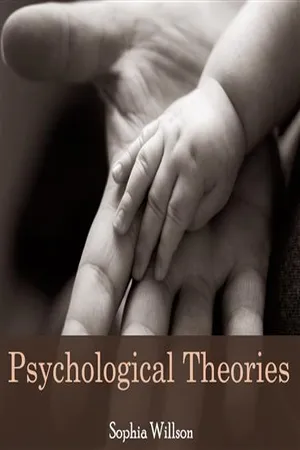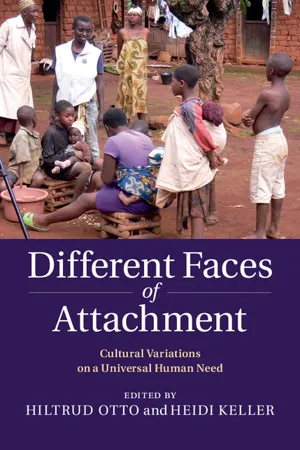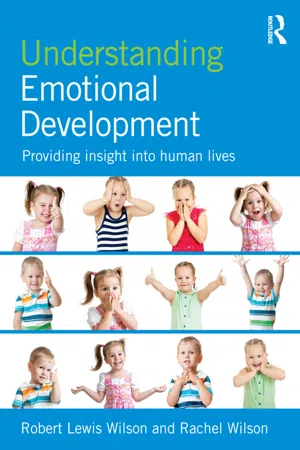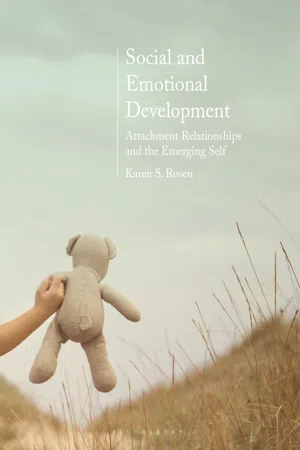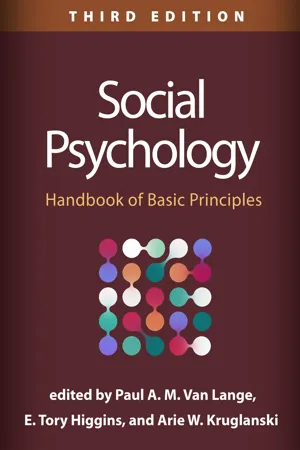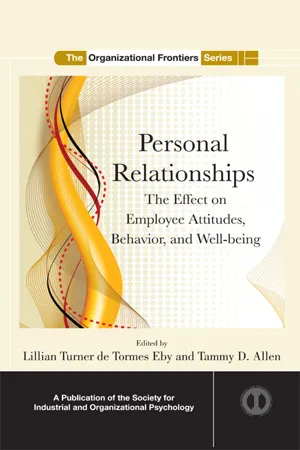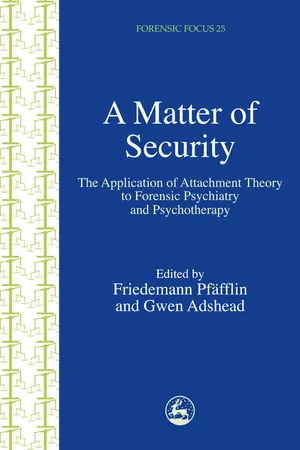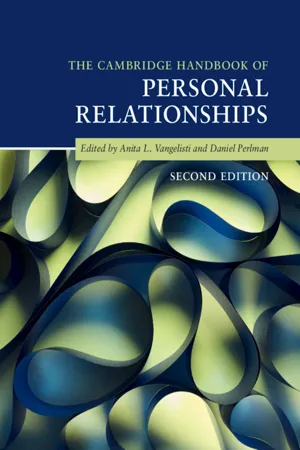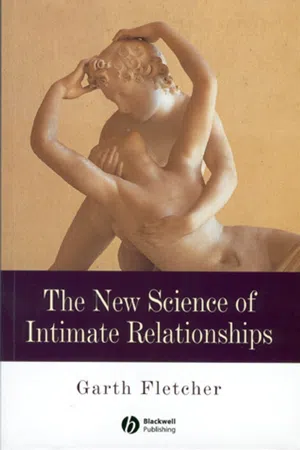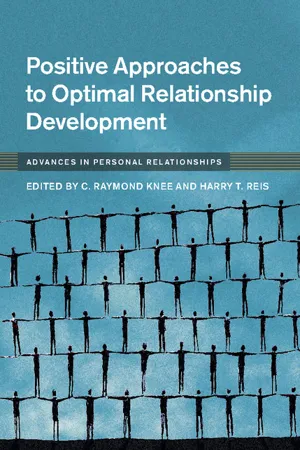Psychology
Attachment and Later Relationships
Attachment theory suggests that early experiences with caregivers shape an individual's later relationships. Secure attachment in infancy is linked to positive adult relationships, while insecure attachment can lead to difficulties in forming and maintaining relationships. These early attachment patterns influence an individual's ability to trust, communicate, and regulate emotions in future relationships.
Written by Perlego with AI-assistance
Related key terms
1 of 5
12 Key excerpts on "Attachment and Later Relationships"
- No longer available |Learn more
- (Author)
- 2014(Publication Date)
- College Publishing House(Publisher)
A fourth pattern, disorganized attachment, was identified later. In the 1980s, the theory was extended to attachment in adults. Other interactions may be construed as including components of attachment behaviour; these include peer relationships at all ages, romantic and sexual attraction and responses to the care needs of infants or the sick and elderly. In the early days of the theory, academic psychologists criticized Bowlby, and the psych-oanalytic community ostracised him for his departure from psychoanalytical tenets; however, attachment theory has since become the dominant approach to understanding early social development, and has given rise to a great surge of empirical research into the formation of children's close relationships. Later criticisms of attachment theory relate to temperament, the complexity of social relationships, and the limitations of discrete patterns for classifications. Attachment theory has been significantly modified as a result of empirical research, but the concepts have become generally accepted. Attachment theory has formed the basis of new therapies and informed existing ones, and its concepts have been used in the formulation of social and childcare policies to support the early attachment relationships of children. ______________________________ WORLD TECHNOLOGIES ______________________________ Attachment Although it is usual for the mother to be the primary attachment figure, infants will form attachments to any caregiver who is sensitive and responsive in social interactions with them. Within attachment theory, attachment means an affectional bond or tie between an individual and an attachment figure (usually a caregiver). Such bonds may be reciprocal between two adults, but between a child and a caregiver these bonds are based on the child's need for safety, security and protection, paramount in infancy and childhood. - eBook - PDF
Different Faces of Attachment
Cultural Variations on a Universal Human Need
- Hiltrud Otto, Heidi Keller(Authors)
- 2014(Publication Date)
- Cambridge University Press(Publisher)
Introduction: understanding relationships – what we would need to know to conceptualize attachment as the cultural solution of a universal developmental task Heidi Keller The definition of attachment as a primary bond between infants and caregivers emerging at around 1 year of age as an evolved adaptation for ensuring survival and development was the seminal contribution of the British psychiatrist and psychoanalyst John Bowlby and his (later) Canadian-American counterpart Mary Ainsworth (Ainsworth, Blehar, Waters et al., 1978; Bowlby, 1969). Attachment theory has initiated a tremendous body of research over the last decades, particularly expand- ing its focus on neurophysiological regulations, and extending it to adult- hood and clinical applications. Nevertheless, the theoretical and method- ological foundations have remained amazingly unaffected, although the basis of knowledge concerning the infant’s socioemotional development has increased substantially since the publication of Bowlby’s well-known trilogy Attachment and Loss and Ainsworth and collaborators’ summary of their empirical research on the emergence of attachment during the first year of life (1978). The first encompassing proposal for the refine- ment of conceptual and methodological issues of attachment theory and research was published by Michael Lamb and collaborators in 1984 in the renowned journal Behavioral and Brain Sciences – though without any observable notice by other attachment researchers. Attachment theory is grounded in evolutionary theory with its basic tenet that every human characteristic is shaped through selection pro- cesses and represents an adaptation to contextual demands. Bowlby stressed explicitly the contextual nature of attachment in his early writ- ings. - eBook - ePub
Child Development for Child Care and Protection Workers
Second Edition
- Brigid Daniel, Sally Wassell, Robbie Gilligan(Authors)
- 2011(Publication Date)
- Jessica Kingsley Publishers(Publisher)
Chapter 2 Developing Relationships Introduction This chapter will set out the underpinning theoretical framework for the book. We will explore attachment theory and draw out issues of particular interest for all professionals working with children and their families. Why attachment theory? Originated by Bowlby (1969) and further developed by Ainsworth et al. (1978) this theoretical framework helps all practitioners to make sense of the development and behaviours of children and young people. These theorists developed a view that a close relationship with at least one responsive and reliable adult is vital for healthy development. The child learns about his emotions through repeated reciprocal interactions with a small number of care-givers. Through a process of sharing of emotion with his attachment figure/s the child learns how to recognise, understand and express his own feelings. The presence of a responsive care-giver helps the young child to regulate his feeling states so that he is not overwhelmed. Bowlby emphasises in his early work the child’s experience of a warm, intimate and continuous relationship, rather than emphasising the fact that it must be the child’s biological mother who offers this ‘secure base’. He also stresses the importance of a relationship with a sensitive and attuned attachment figure as the key to the mental and developmental progress for the child in all domains - eBook - PDF
Understanding Emotional Development
Providing insight into human lives
- Robert Lewis Wilson, Rachel Wilson(Authors)
- 2014(Publication Date)
- Routledge(Publisher)
Attachment originates with the infant and develops into a reciprocal interchange between the child and his or her caregiver that satisfies the child’s most basic dependency needs and allows the child to explore his or her surroundings. The attachment relationship is the baby’s first emotional relationship and if satisfactory is the one from which the child draws emotional comfort and security. Children will seek out the caregiver to whom they are most closely attached whenever they need comfort or when they are injured. Attachment has very close links with a child’s sense of security. Security for the child is based on predictability. The child and the caregiver have had a long period of reciprocal interaction, and they know each other intimately. This allows the child to be able to predict what will happen in the caregiver’s presence. This ability to predict creates a sense of security in the infant and allows the child to explore his or her environment with confidence using the caregiver as a secure base. A sense of security counters anxiety, the emotion that is fuelled by unpredictability. According to Bowlby, the founder of attachment theory, attachment is an enduring emotional tie between infant and caregiver (Bowlby, 1982). Bowlby saw attachment as a way in which infants can reconcile their desire to explore with their wish to be secure and safe. The child uses the caregiver to whom they are attached as a secure base from which to venture into the world, but also as a person to whom they can run whenever danger or strangeness (we would say unpredict- ability) threatens. Attachment and bonding Bonding is a word used in the literature in several senses. Sometimes it is used to mean attachment. At other times bonding is used to mean the attraction that the adult feels for the child, more specifically the feelings of attraction that a mother has towards her newborn infant. - eBook - PDF
Social and Emotional Development:
Attachment Relationships and the Emerging Self
- Karen Rosen(Author)
- 2017(Publication Date)
- Red Globe Press(Publisher)
An extensive body of research supports Bowlby’s idea that early attachment relationships play a critical role in the development of concurrent and later social, emotional, and cognitive competencies. The emotional significance of early attachment rela-tionships is profound and extends throughout the lifespan. Researchers have extended beyond the focus on normative development and studied the developmental outcomes of children who experience threats to the availability of caregivers or disruptions in attachment bonds (for example, when there is parental hostility or inconsistency, maltreatment, or maternal depression). Additionally, attachment theory has been used to guide empirical questions about how early relationships influence the development of par-ticular processes central to adaptation or maladaptation. Thus, for example, developmental researchers have explored the influence of early attachment experiences on developing emotion regulation, behavioral organization, coping strategies, and the construction of cognitive models for representing the self and relationships (for reviews, see DeKlyen & Greenberg, 2008; Egeland & Carlson, 2004; Kobak, Cassidy, Lyons-Ruth, & Ziv, 2006). The quality of the early attachment relationship has been found either to buffer against other risks and serve as a protective factor (for example, secure attachment may protect against the traumatizing effects of abuse) or to increase the risk of maladaptive solutions to developmental tasks (Cicchetti, Toth, & Lynch, 1995). Profound disturbances in attachment relationships have been associ-ated with impairments in children’s social and emotional functioning and may serve as a risk factor for developing psychopathology. These empirical findings have not only deepened our understanding of the processes involved in the development of pathology, but they have also opened new directions for clinical intervention programs. - eBook - PDF
- Ross D. Parke, Glenn I. Roisman, Amanda J. Rose(Authors)
- 2019(Publication Date)
- Wiley(Publisher)
His wife is delighted when he comes to, only to discover that the man she loved has disappeared and his behavior now veers from angry to childlike. 127 CHAPTER 4 Nick Stevens/Cultura/Getty Images The development of attachment relationships is a major achievement in the infant’s early social life. In the first days, weeks, and months of life, infants come to discriminate between familiar people and strangers, and by the end of the first year or so, they develop a loving attachment to one or two of the special people who are regular participants in their lives: mother, father, an older sibling, perhaps a grandparent. Visible signs of attachment can be seen in the warm greetings children give these people, smiling broadly and stretching out their arms as they approach, and then initiating physical contact by touching and snuggling close. Children also make efforts to stay near these people in unfamiliar situations, crawling or running after them and grabbing on to an arm or a leg. They are often distressed when these special people leave them temporarily. They have formed a deep, affectionate, close, and enduring attachment to these important figures. Attachment is of interest to researchers because it is intense and dramatic and because it offers a window into children’s social development and emotional well- being. In this chapter, we trace the remarkable journey by which children develop these first love relationships. We present several theories that psychologists have pro- posed to explain the development of attachment relationships. We then describe the changes in infants’ behavior as attachments form, explore the factors that influence the development of attachment relationships, and examine individual differences in attachment relationships. We also examine the consequences of attachment for Attachment Forming Close Relationships At 3 months of age, Emma watched her mother leave the room, but she did not pro- test. - eBook - PDF
Social Psychology
Handbook of Basic Principles
- Paul A. M. Van Lange, E. Tory Higgins, Arie W. Kruglanski(Authors)
- 2020(Publication Date)
- The Guilford Press(Publisher)
M. (2000). A secure base from which to explore close relationships. Child Development, 71, 164–172. Zeifman, D. M., & Hazan, C. (2016). Pair bonds as attachments: Mounting evidence in support of Bowlby’s hypothesis. In J. Cassidy & P. R. Shaver (Eds.), Handbook of attachment: Theo- ry, research, and clinical applications (3rd ed., pp. 416–434). New York: Guilford Press. 240 F ew aphorisms are as timeworn as “humans are social animals.” Yet packed into this un- deniable truth is an abundance of assumptions, propositions, and questions that have preoccu- pied philosophers, political and religious lead- ers, novelists, poets, and scientists for centuries. In the past 100 or so years, a scholarly disci- pline has emerged that accepts this assertion as a starting point and uses empirical methods to better understand its roots, mechanisms, and implications. That discipline is, of course, so- cial psychology, the subject matter of this vol- ume (for historical reviews, see Jahoda, 2007; Kruglanski & Stroebe, 2012; Reis, 2019). Although the social world influences our be- havior in many and diverse ways, in this chapter I posit more precisely as fundamental the ongo- ing relationships in which most human activ- ity is carried out (Reis, Collins, & Berscheid, 2000). From birth to the end of life, our associa- tions with other people, especially significant others, profoundly affect our thoughts, feelings, activities, and well-being. In spite of this real- ity, and perhaps ironically, theories in social psychology do not always account for the rela- tionship context of behavior. In this chapter, I offer a framework for such an accounting. This framework begins with the idea that human be- havior often depends on who else is involved in a situation, and how one’s relationship with that person (or those persons) influences our per- ceptions, preferences, and actions. These latter attributes, in turn, depend on people’s motives with respect to their interaction partners. - eBook - PDF
Personal Relationships
The Effect on Employee Attitudes, Behavior, and Well-being
- Lillian Turner de Tormes Eby, Tammy D. Allen, Lillian Turner de Tormes Eby, Tammy D. Allen(Authors)
- 2012(Publication Date)
- Routledge(Publisher)
Thus, children who develop an anxious attachment style in childhood will replicate that style in adult love relationships; secure and avoidant children will do the same (Hazan & Shaver, 1990). Of course, this same pattern should be and is seen in organizational settings, with attachment playing a role in the workplace (e.g., Nelson & Quick, 1991; Simmons, Gooty, Nelson, & Little, 2009). In sum, attachment theory focuses on the early caregiving relationships that individuals develop and generalize to their adult relationships. Trust, then, would be seen from the perspective of attachment theory as some- thing developed in early experiences of secure attachment styles, whereas distrust would be developed and generalized from early experiences of insecure attachment. Problems with forming trusting relationships in adults would link back to those early experiences and operate in trait-like ways in adults. Interdependence theory (Thibaut & Kelley, 1959) offers another primary theoretical approach to relationships. Interdependence theory focuses on the pattern of costs and benefits experienced by the individuals in the relational interaction. These are often expressed in matrix form, where Individual A has two behavioral choices and Individual B has two behav- ioral choices. For example, the classic prisoner’s dilemma (or PDG) is a matrix where two individuals benefit most if one defects and the other cooperates but where the pair of individuals benefit most when both coop- erate (for a recent review, see Rusbult & Van Lange, 2008). Theoretical Approaches to Workplace Relationships • 21 Key to interdependence theory is that relational processes emerge from the structure of the relational interactions. To use our example of trust, it is conceptualized in interdependence theory as a macromotive that emerges from repeated interactions with another who has the opportunity to take advantage of you but does not. - eBook - PDF
A Matter of Security
The Application of Attachment Theory to Forensic Psychiatry and Psychotherapy
- Friedemann Pfafflin, Gwen Adshead(Authors)
- 2003(Publication Date)
- Jessica Kingsley Publishers(Publisher)
During the ‘attachment boom’ there has been an explosion of terms relating to different theoretical constructs of attachment. A review of the recently published attachment literature abstracts from January 2000 until May 2002 revealed a multitude of terms used in a rather confusing way. In this chapter the usage of terms is discussed with respect to their core meaning, and the adequacy of their application is evaluated. In order to provide a basis for empirical comparisons, social science requires a clear and specific conceptualisation of terminology. The terms ‘attachment style’, ‘– representation’, ‘– pattern’, ‘– quality’, ‘– status’, ‘– organisation’, ‘– class/classification’, and ‘– type/prototype’ are discussed in some detail and suggestions for further usage are made. 57 INTRODUCTION In his writings about attachment John Bowlby integrated elements of psy-choanalysis, ethology, and control-and learning theory into a theory which has greatly influenced theoretical concepts of developmental psychology, clinical psychology, psychoanalysis, and psychiatry. In his works on 1. ‘at-tachment’, 2. ‘separation’, 3. ‘loss, sadness and depression’ he focused on the central role of interpersonal relationships for social development and psychological functioning throughout life (Bowlby 1969, 1973, 1980). His theoretical considerations of attachment relationships were led by one central observation: in case of perceived physiological or psychological threat or danger, children tend to preserve their psychological integrity by seeking protection with primary caregivers. He developed two major hypotheses regarding the origin of inter-individual differences of attach-ment: 1. Through a history of responsive care, children will evolve expectations (inner working models) of their caregivers’ likely responses to signs of distress or other signals of the desire for contact. - Anita L. Vangelisti, Daniel Perlman(Authors)
- 2018(Publication Date)
- Cambridge University Press(Publisher)
Can you tell that I’m in a relationship? Attachment and relationship visibi- lity on Facebook. Personality and Social Psychology Bulletin, 40, 1466–1479. Etcheverry, P. E., Le, B., Wu, T. F., & Wei, M. (2013). Attachment and the investment model: Predictors of relationship commit- ment, maintenance, and persistence. Personal Relationships, 20, 546–567. Feeney, B. C., & Collins, N. L. (2001). Predictors of caregiving in adult intimate relationships: An attachment theoretical per- spective. Journal of Personality and Social Psychology, 80, 972– 994. Feeney, B. C., Collins, N. L., Van Vleet, M., & Tomlinson, J. M. (2013). Motivations for providing a secure base: Links with attachment orientation and secure base support behavior. Attachment & Human Development, 15, 261–280. Feeney, B. C., & Thrush, R. L. (2010). Relationship influences on exploration in adulthood: The characteristics and function of a secure base. Journal of Personality and Social Psychology, 98, 57–76. Fraley, R. C., & Shaver, P. R. (2000). Adult romantic attachment: Theoretical developments, emerging controversies, and unan- swered questions. Review of General Psychology, 4, 132–154. Gallagher, M. E., Tasca, G. A., Ritchie, K., Balfour, L., Maxwell, H., & Bissada, H. (2014). Interpersonal learning is associated with improved self-esteem in group psychotherapy for women with binge eating disorder. Psychotherapy, 51, 66–77. Gallo, L. C., & Smith, T. W. (2001). Attachment style in marriage: Adjustment and responses to interaction. Journal of Social and Personal Relationships, 18, 263–289. Garrison, A. M., Kahn, J. H., Sauer, E. M., & Florczak, M. A. (2012). Disentangling the effects of depression symptoms and adult attachment on emotional disclosure. Journal of Counseling Psychology, 59, 230–239. Gere, J., MacDonald, G., Joel, S., Spielmann, S. S., & Impett, E. A. (2013). The independent contributions of social reward and threat perceptions to romantic commitment.- eBook - PDF
- Garth J. O. Fletcher(Author)
- 2008(Publication Date)
- Wiley-Blackwell(Publisher)
And, I imagine, if you are one of those people, you may be feeling distinctly uncomfortable if not a little indignant. Fear not, because it turns out that such adult relationship attachment styles are not necessarily per-manent across adulthood, nor are they unshakable structures set in con-crete during childhood. Stability and Change in Relationship Attachment Styles Studies that have tracked attachment styles from toddlerhood (using the Ainsworth strange situation) to adulthood (18–20 years of age) were only just being published as I wrote this chapter (for obvious rea-sons, given that the Ainsworth strange situation was only developed in the 1970s). The findings they have produced are mixed. In four recent longitudinal studies reported in 2000 in Child Development , two found that attachment styles measured in toddlerhood correlated positively, from .44 to .49, with attachment styles as assessed at ages 18–21. How-ever, the other two studies reported no evidence of any consistency across time. 14 Significantly, however, analyses in all four studies sug-gested that changes in attachment styles across the intervening years were not just random, statistical noise. Those who slipped from a se-cure to an insecure style were more likely to have experienced their parents divorcing, physical or sexual abuse, a major debilitating illness of a parent, and so forth. Attachment and Intimacy 158 One study, by Michael Lewis and others, found that 89% of the se-curely attached infants shifted to an insecure style if their parents subse-quently divorced, whereas this was the case for only 35% of the securely attached infants whose parents remained together. A similar pattern was obtained with the infants who were classified as avoidant or am-bivalent – those with divorced parents tended to remain insecure (60%) whereas those whose parents stayed together were less likely to stay insecure (32%) and more likely to shift to a secure style. - C. Raymond Knee, Harry T. Reis(Authors)
- 2016(Publication Date)
- Cambridge University Press(Publisher)
Psycho-Oncology, 16, 1080–1091. Salvatore, J. E., Kuo, S. I., Steele, R. D., Simpson, J. A., & Collins, W. A. (2011). Recovering from conflict in romantic relationships: A developmental perspective. Psychological Science, 22, 376–383. Scharfe, E., & Bartholomew, K. (1995). Accommodation and attachment representa- tions in young couples. Journal of Social and Personal Relationships, 12, 389–401. Scinta, A., & Gable, S. L. (2005). Performance comparisons and attachment: An investigation of competitive responses in close relationships. Personal Relationships, 12, 357–372. Shallcross, S. L., Howland, M., Bemis, J., Simpson, J. A., and Frazier, P. (2011). Not “capitalizing” on social capitalization interactions: The role of attachment insecur- ity. Journal of Family Psychology, 25, 77–85. Shaver, P. R., & Hazan, C. (1988). A biased overview of the study of love. Journal of Social and Personal Relationships, 5, 473–501. Shaver, P. R., & Mikulincer, M. (2002). Attachment-related psychodynamics. Attachment and Human Development, 4, 133–161. Shaver, P. R., Mikulincer, M., Lavy, S., & Cassidy, J. (2009). Understanding and altering hurt feelings: An attachment-theoretical perspective on the generation and regulation of emotions. In A. Vangelisti (Ed.), Feeling hurt in close relationships (pp. 92–121). New York: Cambridge University Press. Simpson, J. A., Collins, W. A., Tran, S., & Haydon, K. C. (2007). Attachment and the experience and expression of emotions in adult romantic relationships: A developmental perspective. Journal of Personality and Social Psychology, 92, 355–367. Simpson, J. A., Rholes, W. S., & Nelligan, J. S. (1992). Support seeking and support giving within couples in an anxiety-provoking situation: The role of attachment styles. Journal of Personality and Social Psychology, 62, 434–446. Simpson, J. A., Rholes, W. S., Orina, M., & Grich, J. (2002). Working models of attachment, support giving, and support seeking in a stressful situation.
Index pages curate the most relevant extracts from our library of academic textbooks. They’ve been created using an in-house natural language model (NLM), each adding context and meaning to key research topics.
